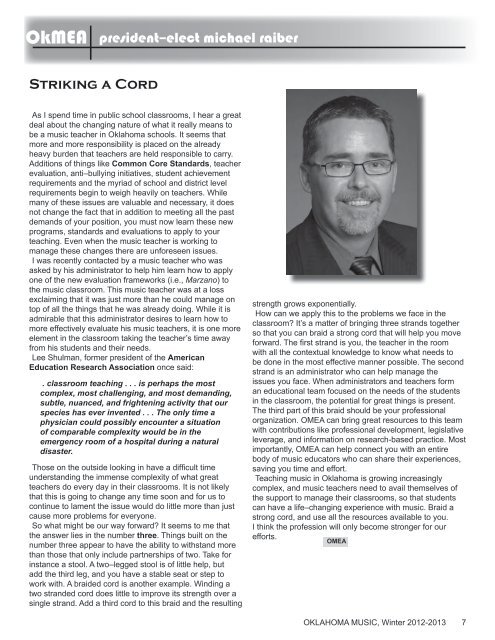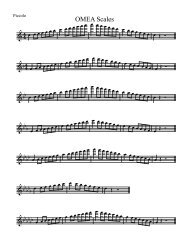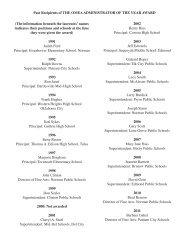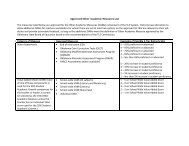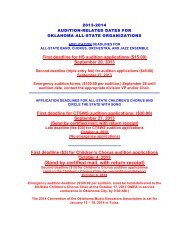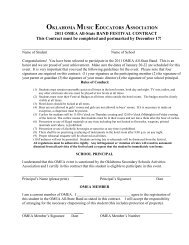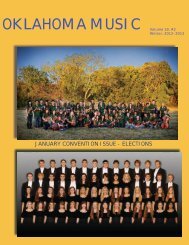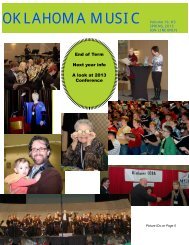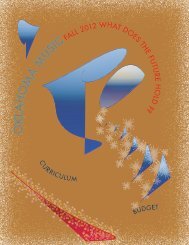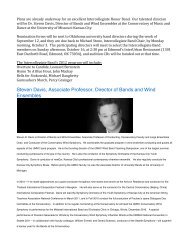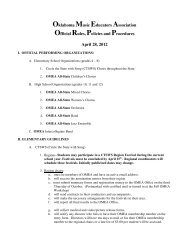WINTER OKLAMUSIC 12 13 II small file.pdf - Oklahoma Music ...
WINTER OKLAMUSIC 12 13 II small file.pdf - Oklahoma Music ...
WINTER OKLAMUSIC 12 13 II small file.pdf - Oklahoma Music ...
Create successful ePaper yourself
Turn your PDF publications into a flip-book with our unique Google optimized e-Paper software.
OkMEA<br />
president–elect michael raiber<br />
Striking a Cord<br />
As I spend time in public school classrooms, I hear a great<br />
deal about the changing nature of what it really means to<br />
be a music teacher in <strong>Oklahoma</strong> schools. It seems that<br />
more and more responsibility is placed on the already<br />
heavy burden that teachers are held responsible to carry.<br />
Additions of things like Common Core Standards, teacher<br />
evaluation, anti–bullying initiatives, student achievement<br />
requirements and the myriad of school and district level<br />
requirements begin to weigh heavily on teachers. While<br />
many of these issues are valuable and necessary, it does<br />
not change the fact that in addition to meeting all the past<br />
demands of your position, you must now learn these new<br />
programs, standards and evaluations to apply to your<br />
teaching. Even when the music teacher is working to<br />
manage these changes there are unforeseen issues.<br />
I was recently contacted by a music teacher who was<br />
asked by his administrator to help him learn how to apply<br />
one of the new evaluation frameworks (i.e., Marzano) to<br />
the music classroom. This music teacher was at a loss<br />
exclaiming that it was just more than he could manage on<br />
top of all the things that he was already doing. While it is<br />
admirable that this administrator desires to learn how to<br />
more effectively evaluate his music teachers, it is one more<br />
element in the classroom taking the teacher’s time away<br />
from his students and their needs.<br />
Lee Shulman, former president of the American<br />
Education Research Association once said:<br />
. classroom teaching . . . is perhaps the most<br />
complex, most challenging, and most demanding,<br />
subtle, nuanced, and frightening activity that our<br />
species has ever invented . . . The only time a<br />
physician could possibly encounter a situation<br />
of comparable complexity would be in the<br />
emergency room of a hospital during a natural<br />
disaster.<br />
Those on the outside looking in have a difficult time<br />
understanding the immense complexity of what great<br />
teachers do every day in their classrooms. It is not likely<br />
that this is going to change any time soon and for us to<br />
continue to lament the issue would do little more than just<br />
cause more problems for everyone.<br />
So what might be our way forward? It seems to me that<br />
the answer lies in the number three. Things built on the<br />
number three appear to have the ability to withstand more<br />
than those that only include partnerships of two. Take for<br />
instance a stool. A two–legged stool is of little help, but<br />
add the third leg, and you have a stable seat or step to<br />
work with. A braided cord is another example. Winding a<br />
two stranded cord does little to improve its strength over a<br />
single strand. Add a third cord to this braid and the resulting<br />
strength grows exponentially.<br />
How can we apply this to the problems we face in the<br />
classroom? It’s a matter of bringing three strands together<br />
so that you can braid a strong cord that will help you move<br />
forward. The first strand is you, the teacher in the room<br />
with all the contextual knowledge to know what needs to<br />
be done in the most effective manner possible. The second<br />
strand is an administrator who can help manage the<br />
issues you face. When administrators and teachers form<br />
an educational team focused on the needs of the students<br />
in the classroom, the potential for great things is present.<br />
The third part of this braid should be your professional<br />
organization. OMEA can bring great resources to this team<br />
with contributions like professional development, legislative<br />
leverage, and information on research-based practice. Most<br />
importantly, OMEA can help connect you with an entire<br />
body of music educators who can share their experiences,<br />
saving you time and effort.<br />
Teaching music in <strong>Oklahoma</strong> is growing increasingly<br />
complex, and music teachers need to avail themselves of<br />
the support to manage their classrooms, so that students<br />
can have a life–changing experience with music. Braid a<br />
strong cord, and use all the resources available to you.<br />
I think the profession will only become stronger for our<br />
efforts.<br />
OMEA<br />
OKLAHOMA MUSIC, Winter 20<strong>12</strong>-20<strong>13</strong> 7


